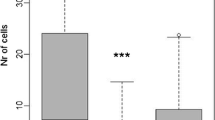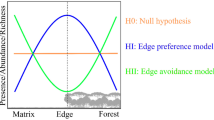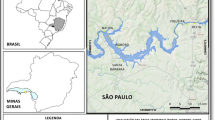Abstract
The combined effects of habitat fragmentation and climate change on biodiversity and biotic interactions are poorly understood. In the context of ongoing deforestation and agricultural intensification in the tropics secondary rainforest fragments might contribute to biodiversity conservation and mitigation of climate warming. This study investigated the interactive effects of habitat fragmentation and microclimate on the abundance and biotic interactions of trap-nesting bees and wasps in secondary forest fragments in the northwestern lowlands of Costa Rica. Fragment size did not affect hymenopteran abundance, parasitism and mortality rates, but all variables differed between edge and interior locations in the forest fragments. Interactive effects between size and location indicate higher mortality rates at interior locations in larger fragments. Microclimatic differences at edge and interior locations led to significant effects on all tested response variables. Abundance at interior locations was significantly higher with increasing temperatures. Mortality rates at interior location increased at lower mean temperatures, whereas higher temperatures at edges marginally increased mortality rates. Our results indicate that edge effects, mediated by altered microclimatic conditions, significantly change biotic interactions of trap-nesting hymenopterans in small secondary fragments.




Similar content being viewed by others
References
Barlow J, Gardner TA, Araujo IS, Avila-Pires TC, Bonaldo AB, Costa JE, Esposito MC, Ferreira LV, Hawes J, Hernandez MIM, Hoogmoed MS, Leite RN, Lo-Man-Hung NF, Malcolm JR, Martins MB, Mestre LAM, Miranda-Santos R, Nunes-Gutjahr AL, Overal WL, Parry L, Peters SL, Ribeiro-Junior MA, da Silva MNF, da Silva Motta C, Peres CA (2007) Quantifying the biodiversity value of tropical primary, secondary, and plantation forests. Proc Natl Acad Sci USA 104:18555–18560. doi:10.1073/pnas.0703333104
Batista Matos MC, Sousa-Souto L, Almeida RS, Teodoro AV (2013) Contrasting patterns of species richness and composition of solitary wasps and bees (Insecta: Hymenoptera) according to land-use. Biotropica 45:73–79. doi:10.1111/j.1744-7429.2012.00886.x
Buckley LB, Tewksbury JJ, Deutsch CA (2013) Can terrestrial ectotherms escape the heat of climate change by moving? Proc R Soc B 280:1–6
Connor EF, Courtney AC, Yoder JM (2000) Individuals-area relationships: the relationship between animal population density and area. Ecology 81:734–748
Cornell HV, Hawkins BA (1993) Accumulation of native parasitoid species on introduced herbivores: a comparison of hosts as natives and hosts as invaders. Am Nat 141:847–865
Crawley M (2002) Statistics: an introduction using R. Wiley, New York
Davies KF, Margules CR, Lawrence JF (2000) Which traits of species predict population declines in experimental forest fragments? Ecology 81:1450–1461
Debinski DM, Holt RD (2000) A survey and overview of habitat fragmentation experiments. Conserv Biol 14:342–355
Deutsch CA, Tewksbury JJ, Huey RB, Sheldon KS, Ghalambor CK, Haak DC, Martin PR (2008) Impacts of climate warming on terrestrial ectotherms across latitude. PNAS 105:6668–6672
Didham RK, Ghazoul J, Stork NE, Davis AJ (1996) Insects in fragmented forests: a functional approach. Trends Ecol Evol 11:255–260
Donovan TM, Flather CM (2002) Relationships among North American songbird trends, habitat fragmentation and landscape occupancy. Ecol Appl 12:364–374
Ewers RM, Thorpe S, Didham RK (2007) Synergistic interactions between edge and area effects in a heavily fragmented landscape. Ecology 88:96–106
Ewers RM, Scharlemann JPW, Balmford A, Green RE (2009) Do increases in agricultural yield spare land for nature? Glob Chang Biol 15:716–726
Fahrig L (2003) Effects of habitat fragmentation on biodiversity. Annu Rev Ecol Evol Syst 34:487–515. doi:10.1146/annurev.ecolsys.34.011802.132419
Fenoglio MS, Srivastava D, Valladares G, Cagnolo L, Salvio A (2012) Forest fragmentation reduces parasitism via species loss at multiple trophic levels. Ecology 93:2407–2420
Frankie GW, Vinson SB, Newstrom LE, Barthell JF (1988) Nest site and habitat preferences of Centris bees in the Costa Rican dry forest. Biotropica 20:301–310
Fye RE (1972) The effect of forest disturbances on populations of wasps and bees in Northwestern Ontario (Hymenoptera: Aculeata). Can Entomol 104:1623–1633
Gascon C, Lovejoy TE, Bierregard RO, Malcolm JR, Stouffer PC, Vasconcelos HL, Laurance WF, Zimmerman B, Tocher M, Borges S (1999) Matrix habitat and species richness in tropical forest remnants. Biol Conserv 91:223–229
Gibbs JP (2001) Demography versus habitat fragmentation as determinants of genetic variation in wild populations. Biol Conserv 100:15–20
Gibson L, Lynam AJ, Bradshaw CJA, He F, Bickford DP, Woodruff DS, Bumrungsri S, Laurance WF (2013) Near-complete extinction of native small mammal fauna 25 years after forest fragmentation. Science 80(341):1508–1510. doi:10.1126/science.1240495
Godfray HC, Lewis T, Memmott J (1999) Studying insect diversity in the tropics. Philos Trans R Soc Lond B 354:1811–1824. doi:10.1098/rstb.1999.0523
González-Varo JP, Biesmeijer JC, Bommarco R, Potts SG, Schweiger O, Smith HG, Steffan-Dewenter I, Szentgyörgyi H, Woyciechowski M, Vilà M (2013) Combined effects of global change pressures on animal-mediated pollination. Trends Ecol Evol 28:524–530. doi:10.1016/j.tree.2013.05.008
Hanski I, Zurita GA, Bellocq MI, Rybicki J (2013) Species-fragmented area relationship. Proc Natl Acad Sci USA 110:12715–12720. doi:10.1073/pnas.1311491110
Hill JK, Hughes CL, Dytham C, Searle JB (2006) Genetic diversity in butterflies: interactive effects of habitat fragmentation and climate-driven range expansion. Biol Lett 2:152–154. doi:10.1098/rsbl.2005.0401
Holdridge LR (1967) Life zone ecology. Tropical Science Center, San Jose
Holt RD, Lawton JH, Polis GA, Martinez ND (1999) Trophic rank and the species-area relationship. Ecology 80:1495–1504
Hunter MD (2002) Landscape structure, habitat fragmentation, and the ecology of insects. Agric For Entomol 4:159–166. doi:10.1046/j.1461-9563.2002.00152.x
Klein A-M, Steffan-Dewenter I, Buchori D, Tscharntke T (2002) Effects of land-use intensity in tropical agroforestry systems on coffee flower-visiting and trap-nesting bees and wasps. Conserv Biol 16:1003–1014. doi:10.1046/j.1523-1739.2002.00499.x
Klein A-M, Steffan-Dewenter I, Tscharntke T (2006) Rain forest promotes trophic interactions and diversity of trap-nesting Hymenoptera in adjacent agroforestry. J Anim Ecol 75:315–323. doi:10.1111/j.1365-2656.2006.01042.x
Kremen C, Williams NM, Aizen MA, Gemmill-Herren B, LeBuhn G, Minckley R, Packer L, Potts SG, Roulston T, Steffan-Dewenter I, Vázquez DP, Winfree R, Adams L, Crone EE, Greenleaf SS, Keitt TH, Klein A-M, Regetz J, Ricketts TH (2007) Pollination and other ecosystem services produced by mobile organisms: a conceptual framework for the effects of land-use change. Ecol Lett 10:299–314. doi:10.1111/j.1461-0248.2007.01018.x
Krombein KV (1967) Trap-nesting wasps and bees: life histories, nests and associates. Smithsonian Press, Washington
Kruess A, Tscharntke T (2000) Species richness and parasitism in a fragmented landscape: experiments and field studies with insects on Vicia sepium. Oecologia 122:129–137
Kuussaari M, Bommarco R, Heikkinen RK, Helm A, Krauss J, Lindborg R, Ockinger E, Pärtel M, Pino J, Rodà F, Stefanescu C, Teder T, Zobel M, Steffan-Dewenter I (2009) Extinction debt: a challenge for biodiversity conservation. Trends Ecol Evol 24:564–571. doi:10.1016/j.tree.2009.04.011
Laurance WF, Williamson GB (2001) Positive feedbacks among forest fragmentation, drought, and climate change in the Amazon. Conserv Biol 15:1529–1535. doi:10.1046/j.1523-1739.2001.01093.x
Laurance WF, Lovejoy TE, Vasconcelos HL, Bruna EM, Didham RK, Stouffer PC, Gascon C, Bierregaard RO, Laurance SG, Sampaio E (2002) Ecosystem decay of Amazonian forest fragments : a 22-year investigation. Conserv Biol 16:605–618
Laurance WF, Carolina Useche D, Shoo LP, Herzog SK, Kessler M, Escobar F, Brehm G, Axmacher JC, Chen I-C, Gámez LA (2011) Global warming, elevational ranges and the vulnerability of tropical biota. Biol Conserv 144:548–557. doi:10.1016/j.biocon.2010.10.010
Loyola RD, Martins RP (2006) Trap-nest occupation by solitary wasps and bees (Hymenoptera: Aculeata) in a forest urban remnant. Neotrop Entomol 35:41–48
Morato EF, Campos LA de O (2000) Efeitos da fragmentação florestal sobre vespas e abelhas solitárias em uma área da Amazônia Central. Rev Bras Zool 17:429–444
Murcia C (1995) Edge effects in fragmented forests: implications for conservation. Trends Ecol Evol 10:58–62
Offerman HL, Dale VH, Pearson SM, Bierregaard Jr, O`Neill RV (1995) Effects of forest fragmentation on Neotropical fauna: current research and data availability. Environ Rev 3:191–211
Opdam P, Wascher D (2004) Climate change meets habitat fragmentation: linking landscape and biogeographical scale levels in research and conservation. Biol Conserv 117:285–297. doi:10.1016/j.biocon.2003.12.008
Penagos DI, Williams T (1995) Important factors in the biology of heteronomous hyperparasitoids (Hym.: Aphelinidae): agents for the biological control of whiteflies and scale insects. Acta Zool Mex Nueva Ser 66:31–57
Pimm SL, Lawton J (1977) The number of trophic levels in ecological communities. Nature 268:329–331
Potts SG, Vulliamy B, Roberts S, O’Toole C, Dafni A, Ne’eman G, Willmer P (2005) Role of nesting resources in organising diverse bee communities in a Mediterranean landscape. Ecol Entomol 30:78–85. doi:10.1111/j.0307-6946.2005.00662.x
Rand TA, Tylianakis JM, Tscharntke T (2006) Spillover edge effects: the dispersal of agriculturally subsidized insect natural enemies into adjacent natural habitats. Ecol Lett 9:603–614. doi:10.1111/j.1461-0248.2006.00911.x
Ries L, Sisk T (2004) A predictive model of edge effects. Ecology 85:2917–2926
Ruibal R (1961) Thermal relations of five species of tropical lizards. Evolution (NY) 15:98–111
Saunders DA, Hobbs RJ, Margules CR (1991) Biological consequences of ecosystem fragmentation: a review. Conserv Biol 5:18–32. doi:10.1111/j.1523-1739.1991.tb00384.x
Suttle KB, Thomsen MA, Power ME (2007) Species interactions reverse grassland responses to changing climate. Science 315:640–642. doi:10.1126/science.1136401
Taki H, Viana BF, Kevan PG, Silva FO, Buck M (2008) Does forest loss affect the communities of trap-nesting wasps (Hymenoptera: Aculeata) in forests? Landscape versus local habitat conditions. J Insect Conserv 12:15–21. doi:10.1007/s10841-006-9058-1
Tewksbury JJ, Huey RB, Deutsch CA (2008) Putting the heat on tropical animals. Science 320:1296–1297
Thiele R (2005) A new species of Ctenioschelus Romand from Costa Rican dry forest (Hymenoptera : Apidae : Ericrocidini). J Kans Entomol Soc 78:272–276
Thomson LJ, Hoffmann AA (2009) Vegetation increases the abundance of natural enemies in vineyards. Biol Control 49:259–269
Thomson LJ, Robinson M, Hoffmann AA (2001) Field and laboratory evidence for acclimation without costs in an egg parasitoid. Funct Ecol 15:217–221. doi:10.1046/j.1365-2435.2001.00516.x
Tilman D, Fargione J, Wolff B, D’Antonio C, Dobson A, Howarth R, Schindler D, Schlesinger WH, Simberloff D, Swackhamer D (2001) Forecasting agriculturally driven global environmental change. Science 292:281–284. doi:10.1126/science.1057544
Tscharntke T, Gathmann A, Steffan-Dewenter I (1998) Bioindication using trap-nesting bees and wasps and their natural enemies: community structure and interactions. J Appl Ecol 35:708–719. doi:10.1046/j.1365-2664.1998.355343.x
Tscharntke T, Klein AM, Kruess A, Steffan-Dewenter I, Thies C (2005) Landscape perspectives on agricultural intensification and biodiversity: ecosystem service management. Ecol Lett 8:857–874. doi:10.1111/j.1461-0248.2005.00782.x
Turner IM (1996) Species loss in fragments of tropical rain forest: a review of the evidence. J Appl Ecol 33:200–209
Turner IM, Corlett RT (1996) The conservation value of small, isolated fragments of lowland tropical rain forest. Trends Ecol Evol 11:330–333
Tylianakis JM, Klein A-M, Tscharntke T (2005) Spatiotemporal variation in the diversity of Hymenoptera across a tropical habitat gradient. Ecology 86:3296–3302. doi:10.1890/05-0371
Tylianakis JM, Tscharntke T, Klein A-M (2006) Diversity, ecosystem function, and stability of parasitoid-host interactions across a tropical habitat gradient. Ecology 87:3047–3057
Valladares G, Salvo A, Cagnolo L (2006) Habitat fragmentation effects on trophic processes of insect-plant food webs. Conserv Biol 20:212–217. doi:10.1111/j.1523-1739.2006.00337.x
van Berkum FH (1988) Latitudinal patterns of the thermal sensitivity of sprint speed in lizards. Am Nat 132:327–343
van Nouhuys S (2005) Effects of habitat fragmentation at different trophic levels in insect communities. Ann Zool Fennici 433–447
Vitousek PM, Mooney HA, Lubchenco J, Melillo JM (1997) Human domination of Earth’s ecosystems. Science 277:494–496
Wimp GM, Murphy SM, Lewis D, Ries L (2011) Do edge responses cascade up or down a multi-trophic food web? Ecol Lett 14:863–870. doi:10.1111/j.1461-0248.2011.01656.x
Worm B, Duffy JE (2003) Biodiversity, productivity and stability in real food webs. Trends Ecol Evol 18:628–632. doi:10.1016/j.tree.2003.09.003
Acknowledgments
We appreciate the great help of the Costa Rican field assistants, especially Edwin Paniagua Sanchez and Amandine Bourg. We also want to thank the German assistants. Moreover we thank Bernhard Hoiss and Marcell Peters for their support of statistical data analysis, three anonymous reviewers for their valuable comments on the manuscript and Sebastian Hopfenmüller and Wito Lapinski for all their precious comments on the study. We thank the “Deutscher Akademischer Austauschdienst” for financial support.
Author information
Authors and Affiliations
Corresponding author
Additional information
Communicated by Dirk Sven Schmeller.
Electronic supplementary material
Below is the link to the electronic supplementary material.
Rights and permissions
About this article
Cite this article
Stangler, E.S., Hanson, P.E. & Steffan-Dewenter, I. Interactive effects of habitat fragmentation and microclimate on trap-nesting Hymenoptera and their trophic interactions in small secondary rainforest remnants. Biodivers Conserv 24, 563–577 (2015). https://doi.org/10.1007/s10531-014-0836-x
Received:
Revised:
Accepted:
Published:
Issue Date:
DOI: https://doi.org/10.1007/s10531-014-0836-x




